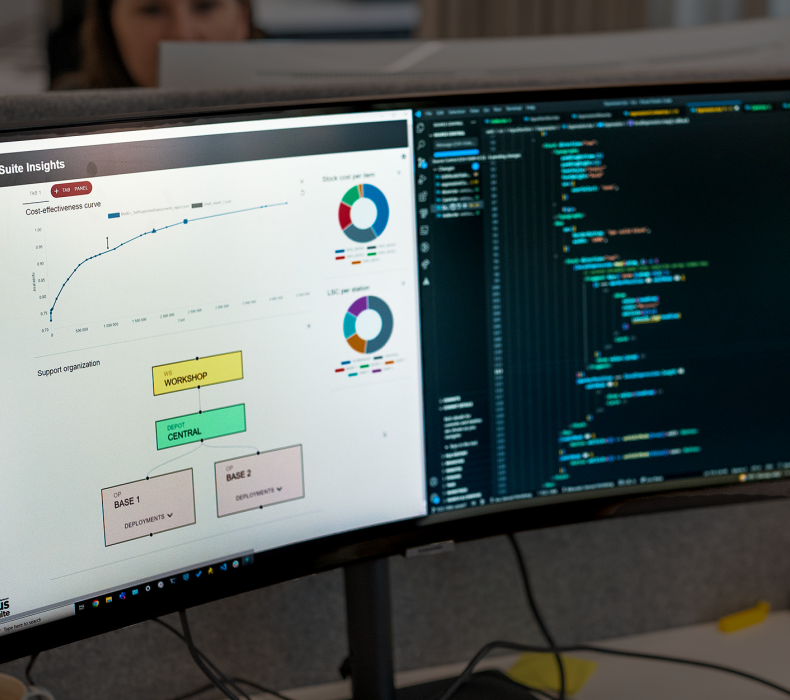

Data Driven Readiness
Get the answers you need for optimal fleet performance.
Life cycle management analysis with Opus Suite.
Don't Guess. Know.
Read more about Opus Suite
Opus Suite – Life Cycle Management Software for Complex Technical Systems.
The world leading software to help predict and assess the impact of your decisions on performance and cost, during the system's entire life cycle.


Optimizing System Effectiveness and Readiness
Explore our articles on how system effectiveness and readiness drive mission success across complex operational domains. From air, land, and naval platforms to critical infrastructure and fast-paced operations, we share insights on strengthening performance, improving availability, and managing risk throughout the system lifecycle.
Our experts examine how structured systems engineering and data-driven analysis turn operational challenges into sustainable mission readiness.
Strategic Optimization of Spares & Logistics Support
OPUS10 is state of the art for strategic cost-effective optimization of maintenance concepts, spares and logistics support for a fleet of technical systems (or systems of systems).
Go to OPUS10
Simulation of Operations & Logistics Support Effectiveness
SIMLOX is ideal for simulating and ensuring the ability of a system fleet and its support solution to meet operational objectives.
Go to SIMLOX
Cost Control Through the Entire Life Cycle
CATLOC is perfect for predicting cost and revenue for technical systems during their life cycle (or any other time period), and for estimating economic consequences of key decisions on system design, operations and logistics support.
Go to CATLOC
Tactical Optimization of Dynamic Scenarios
Opus Evo provides tactical and operational optimization of spares and maintenance equipment. Using evolutionary algorithms and simulation, it accommodates detailed models of systems, support and operations, including dynamic aspects and variations over time.
Go to Opus Evo
Business Intelligence & Visualization
Opus Suite Insights provides powerful visualizations and dashboards for effective communication, understanding and decision support. It is a Business Intelligence tool for LCM that makes it easy to share your Opus Suite analysis results directly with a broader audience and stakeholders.
Go to Opus Insights
Integration & Data Ingestion
Opus Suite Connect simplifies the task of ingesting data to create and populate Opus Suite Models. The time spent on data ingestion can be reduced by 80% using Opus Suite Connect.
Go to Opus Suite Connect
Courses & Training
Systecon provides introductory and expert level courses for the Opus Suite software tools as well as the Life Cycle Management domain.
Events & Conferences
Meet Systecon at different events to discuss real life use cases of analysis-driven LCM and how it can impact availability and mission readiness.
The Platform Trusted by the World’s Leading Defense Organizations

Rolls-Royce

BAE Systems

Airbus

US Navy
Thales

Saab

Brazilian Air Force
Textron
KMW

US Air Force
Leonardo
Raytheon

French Air Force

Rheinmetall

Australian DOD
Hanwha

Singapore MOD

ThyssenKrupp
MBDA

Naval Group
MHI

Northrop Grumman
Embraer
Opus Suite
Trusted by thousands of users globally to provide decision support for LCM.
This is a selection of reference case studies from some of the many Opus Suite clients.


Vattenfall and Scottish Power - Availability Analysis for the East Anglia Wind Energy Project.


Stockholm Public Transport Administration - Maintenance Optimization of Commuter Trains.


Royal Thai Air Force - Education in Logistic Analysis.
Read more about Royal Thai Air Force - Education in Logistic Analysis


BAE Systems - Life Cycle Cost Analysis of Combat Vehicle 90.
Read more about BAE Systems - Life Cycle Cost Analysis of Combat Vehicle 90













